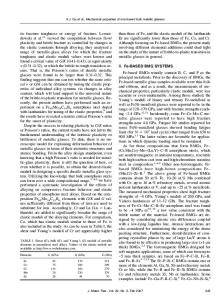The Prospects for Mechanical Ratcheting of Bulk Metallic Glasses
- PDF / 3,287,207 Bytes
- 6 Pages / 612 x 792 pts (letter) Page_size
- 22 Downloads / 371 Views
MM7.5.1
The Prospects for Mechanical Ratcheting of Bulk Metallic Glasses Wendelin J. Wright1, R.H. Dauskardt2, and W.D. Nix2 1 Lawrence Livermore National Laboratory, University of California, Livermore, CA 94550 2 Department of Materials Science and Engineering, Stanford University, Stanford, CA 94305 ABSTRACT The major mechanical shortcoming of metallic glasses is their limited ductility at room temperature. Monolithic metallic glasses sustain only a few percent plastic strain when subjected to uniaxial compression and essentially no plastic strain under tension. Here we describe a room temperature deformation process that may have the potential to overcome the limited ductility of monolithic metallic glasses and achieve large plastic strains. By subjecting a metallic glass sample to cyclic torsion, the glass is brought to the yield surface; the superposition of a small uniaxial stress (much smaller than the yield stress) should then produce increments in plastic strain along the tensile axis. This accumulation of strain during cyclic loading, commonly known as ratcheting, has been extensively investigated in stainless and carbon steel alloys, but has not been previously studied in metallic glasses. We have successfully demonstrated the application of this ratcheting technique of cyclic torsion with superimposed tension for polycrystalline Ti–6Al–4V. Our stability analyses indicate that the plastic deformation of materials exhibiting elastic–perfectly plastic constitutive behavior such as metallic glasses should be stable under cyclic torsion, however, results obtained thus far are inconclusive. STABILITY ANALYSIS Ratcheting in the form of cyclic bending with superimposed tension of thin sheets of metal was first analyzed by Swift [1] and Hill [2]. Early experimental investigations of ratcheting in metals were performed by Coffin [3, 4]. More recently, numerous experimental and analytical investigations of ratcheting in steels have been performed (for example, see [5]). The ratcheting process proposed here for metallic glasses will achieve large plastic strains only if the torsional deformation that is imposed is stable after yielding has occurred. For this reason, we now consider the relationship between the applied torque and the angle of twist after yielding has commenced. During pure torsional deformation under rotational control, one end of a cylindrical sample of radius R and length L is twisted by an angle q relative to the fixed end. The shear rq strain g is given by g = , where r is the radius at which the strain is to be evaluated. The L shear stress t in the elastic core is computed as t = m g , where m is the shear modulus of the mq material. Thus t = r , and the maximum shear stress occurs at the surface of the cylinder L where r = R . The applied torque in a sample subjected to pure shear is found by integrating R
T = Ú (t 2pr dr) r . 0
The applied torque Ty at which yielding commences is calculated by substituting for t with q = q y , the critical angle of twist for yielding, and performing the i
Data Loading...











